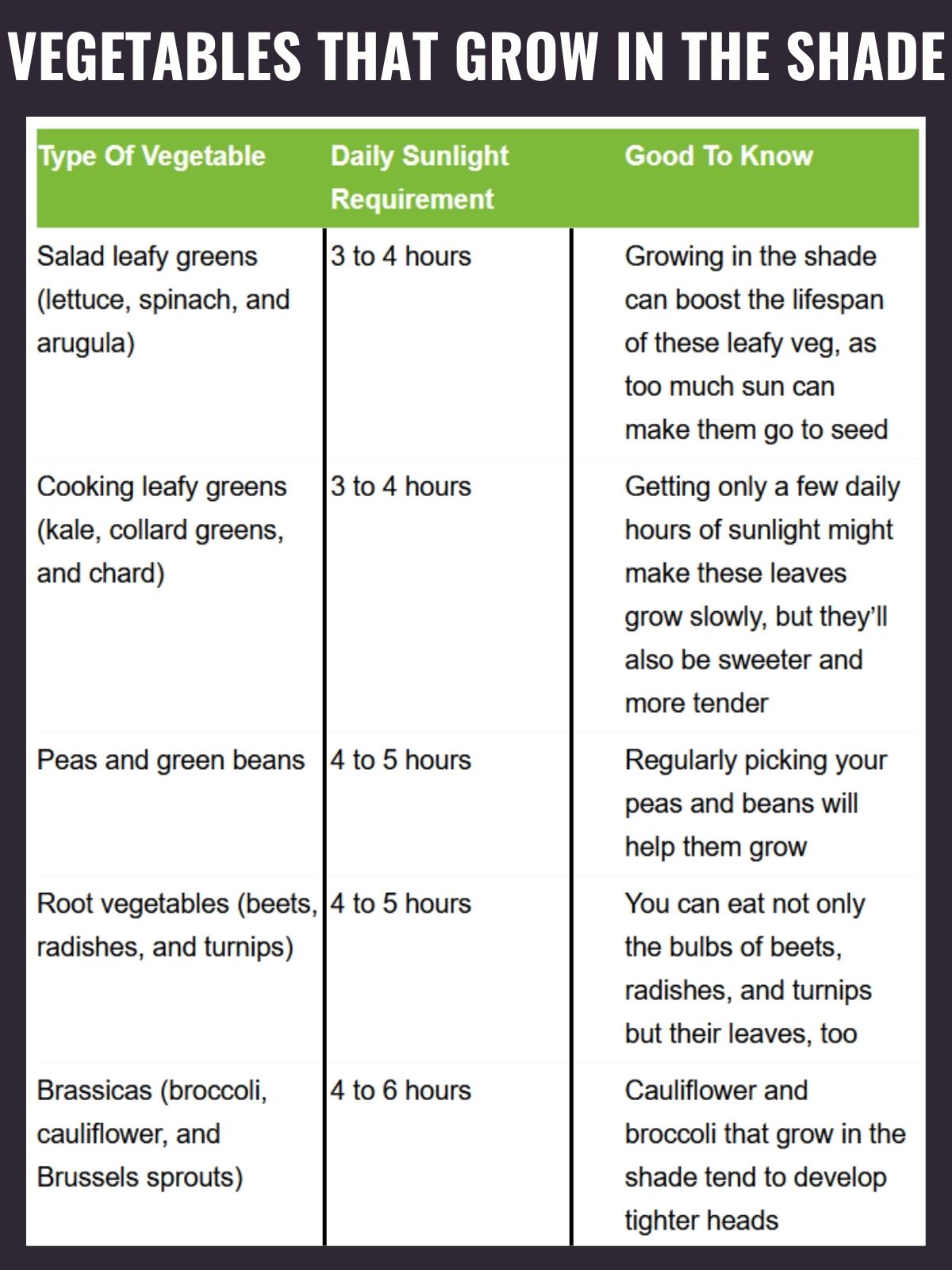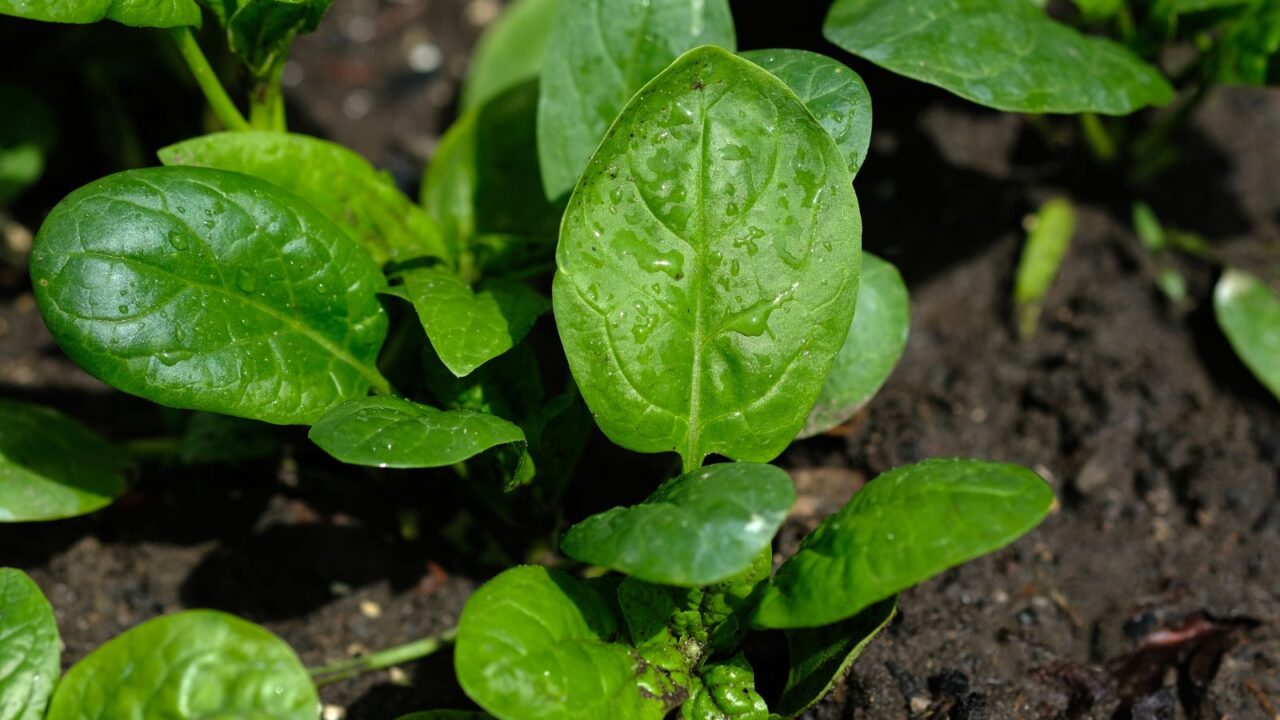If you’ve joined the urban farming movement but your garden gets more shadows than sunlight, don’t worry—you’re not out of luck. It turns out that plenty of vegetables actually prefer a little shade, and with the right choices, your low-light garden can still be productive and delicious.
Leafy greens like lettuce, spinach, and kale thrive in shady spots. So do many brassicas, including broccoli and cauliflower, and even some root vegetables like beets and radishes. But here’s the key: not all shade is created equal.
Through some deeper digging, I discovered that shade comes in different intensities—partial, dappled, or full—and different vegetables have different tolerance levels. Once you know what kind of shade your garden gets, you can match it with the right crops and create a thriving, low-light veggie patch.
Let’s dive into which vegetables grow best in the shade—and how to set your garden up for success.
What Level of Shade Does Your Garden Experience?
Time to be a shade sleuth. Check your veggie patch every half hour from sunrise till sunset and record how much sunlight it receives. (Not home? Set up a time-lapse video if you’re capable.) Note the time, degree (full light, dappled light, or shade), and duration of sunlight exposure.
Do this for about two weeks, then use your findings to work out your garden’s average daily exposure. Many plants are labeled according to their lighting requirements. They may say partial shade, direct sunlight, light shade, shade tolerant, or similar terms. When you have a better understanding of the levels of shade found in your garden, then you can understand how to choose the veggies that will do best there.
When you have this information, you can get a better idea of your garden’s shade level. I’ll share what I’ve learned from my own gardening practices and research.
Dappled Light
This is when sunlight shines through tree leaves throughout most of the day. Gardens that receive dappled light fall into the light or partly shaded category. Sometimes this is also called a dappled shade.
Light or Partial Shade
A garden that receives three to six hours of sunlight a day is considered lightly or partly shaded.
Full Shade
If your garden receives fewer than three hours of sunlight a day, it’s classified as being fully shaded.
Deep Shade
Gardens that get almost no sunlight all day are considered deeply shaded.
What Veggies Grow in The Different Levels of Shade?

Image Credit: Backyard Garden Lover.
If your garden experiences deep shade, almost all vegetables you plant in it will struggle to grow to a decent size or even stay alive. At least a few hours of sun is needed, generally. All vegetables, that is, except for garden cress, a resilient leafy green that can even grow in nearly full shade. Most salad greens can do well with just a bit of sunlight per day.
Gardens that receive at least three hours of sunlight a day, however, can produce plenty of well-growing, nutritious vegetables. So, if you have a few sunny spots that make way to afternoon shade, you’ll be good.
Here’s a book about shade gardening for more information.
Salad Leafy Greens

Image credit: Depositphotos.
Salad leafy greens, such as lettuce, spinach, and arugula, don’t need much sunlight. If you can give these 3 to 4 hours of sun, they’ll do great!
Growing in the shade can also boost the lifespan of these leafy veggies, as too much sun can make them go to seed and wilt, making their leaves taste bitter.
Cooking Leafy Greens
Leafy greens typically used for cooking, such as kale, collard greens, and chard, also need about 3 to 4 hours of sunlight every day. Getting only a few daily hours of sunlight might make these leaves grow slowly, but they’ll also be sweeter and more tender
Peas and Green Beans
Green beans and peas can get by with about 4 to 5 hours of sun. Remember that regularly picking your peas and beans will help them grow, and of course, will keep your family happy with delicious meals and snacks.
Peas don’t like the intense summer heat, so giving them a protected spot in the prime of summer can help them keep producing.
Root Vegetables
Root vegetables such as beets, carrots, radishes, and turnips will grow well with 4 to 5 hours of sun every day. You can eat not only the bulbs of beets, radishes, carrots, and turnips but their leaves, too. You can use them in soups, salads, and even make pesto. YUM!
Brassicas

Image credit: Backyard Garden Lover.
Brassicas, such as broccoli, cauliflower, and Brussels sprouts, need 4 to 6 hours of sun daily to grow well. And cauliflower and broccoli that grow in the shade tend to develop tighter heads.
Signs Your Shade Garden Veggies Need More Sun
You might find it tricky to calculate how many hours of sunlight your garden generally receives. It’s not like you can just stand there and watch it all day and keep a log (or can you?). But there are some ways you can tell if your veggies are getting enough sun, or if they need more. Then you can adjust accordingly.
If you’re worried your veggies might not be getting enough, watch them closely because they’ll show you when they need more time in the sun.
Plants that don’t get enough sunlight will struggle to produce chlorophyll (the pigment that makes them green), and as a result, they can turn pale green, yellow, or white. Their stems can also lengthen and appear to be reaching toward the sun.
How To Create A Thriving Shaded Veggie Patch
Now that you know how much shade you’re working with, you can begin your shady veggie garden. Use these tips to help veggies grow strong and healthy in a shaded garden.
Give your seedlings a good start by first growing them in indoor pots, where you can control their sunlight exposure. When the young plants are growing well, you can transplant them into a shadier spot in your outdoor area.
If it’s a dense canopy of branches that’s casting too much shade for your veggie patch, you could try pruning the leaves of trees to let in more sunlight. Another idea is to paint nearby walls and fences white to reflect more light into your garden.
Something else you could try is planting your veggies in containers under trees and near shrubs, to spare them from having to compete with the tree and shrub roots for water.
Benefits Of Shaded Vegetable Gardens
Sometimes we just have to work with what we’re given, but other times, gardeners want a veggie patch in the shade. Why would you choose to do a shaded vegetable garden? There’s a lot to love about shady veggie patches.
A big bonus is that your vegetables will be protected from the harsh sun, especially in the summertime. This means you’ll have a greater chance of having lusher leafy greens and longer growing periods for crops like peas and green beans.
Your soil will also be more likely to hold on to moisture, so you might not have to water your vegetables as frequently as if they were sun-drenched, too.
A Common Pest in Shaded Vegetable Gardens
There’s a downside to shaded gardens’ cool, moist conditions: they attract slugs.
These slimy, grayish creatures (which look like snails without shells) are a danger to your veggie patch, as they eat seedlings’ leaves, as well as ripening veggies.
Stop slugs in their tracks
Regularly inspect your veggies to make sure they don’t become a slug’s tasty snack. Slugs come out to feast at night, so wait until it’s dark, then use a flashlight to check your plants. Pick off any slugs you find and drown them in soapy water.
Even if you don’t catch any slugs in the act, you’ll know they’ve found their way to your garden if you spot a slimy trail.
Worried that slugs are about to invade your precious veggies? Set traps for them! Damp newspaper sheets work well. Lay out the sheets overnight and check underneath for slugs the next morning. Keep a bucket of soapy water close, so you have somewhere to toss the slugs as you find them.
Your watering habits can also help prevent a slug attack. Always water in the morning and by hand; pour the water near the roots, not over the whole plant; and don’t water the leaves or vegetables directly.
Learn more about keeping slugs under control.
Make the Most of Your Shade
Having a shady garden is no reason to give up on dreams of growing your very own veggies for farm-to-table eating. From your favorite leafy vegetables to navigating cooler weather and the morning sun, there are so many great ways to have a shaded veggie garden.
Whether you want delicious greens that taste of just-picked freshness, baby beets for roasting to caramelized perfection, or a cauliflower head to slice, grill, and top with cheese, you can grow a variety of versatile veggies – even in a garden that’s on the shady side.



10 Great Purple Shade Perennials For Your Garden
Monday 10th of April 2023
[…] Vegetables that grow in the shade […]
10 Yellow Perennials For Shade You'll Fall In Love With
Wednesday 29th of March 2023
[…] Vegetables that grow in the shade […]
9 Pristine White Shade Perennials For Low Light Gardens
Wednesday 29th of March 2023
[…] Vegetables that grow in the shade […]
11 Orange Shade Perennials You'll Love
Wednesday 1st of February 2023
[…] Vegetables that grow in the shade […]